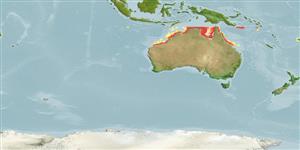>
Atheriniformes (Silversides) >
Atherinidae (Silversides) > Craterocephalinae
Etymology: Craterocephalus: Greek, krater, -eros = bowl, mixing vessel + Greek, kephale = head (Ref. 45335).
Environment: milieu / climate zone / depth range / distribution range
पारिस्थितिकी
समुद्री; खारा. Tropical; 11°S - 21°S
Eastern Indian Ocean and Western Central Pacific: northern Australia, from Western Australia to Fraser Island, around the islands of the Gulf of Carpentaria, and northeast Queensland.
आकार / वज़न / Age
Maturity: Lm ? range ? - ? cm
Max length : 7.0 cm TL पुल्लिंग / अलिंग; (Ref. 9760)
गुदा कांटा: 1. Labial ligament inserting adjacent to symphysis of dentary. Lateral process of premaxilla pungent. Gill rakers on first lower gill arch, 13-17. Body scales on large specimens usually crenulated, midlateral scales 33-37. Black spot often present at base of pectoral fin.
Mainly coastal and estuarine, often schooling with C. capreoli, Atherinomorus endrachtensis and A. ogilbyi. Diet includes crustaceans and diatoms. Breeds from December to March throughout the southern hemisphere. Appears to have a one year life span. May be food fish for larger commercially important fishes.
Life cycle and mating behavior
Maturities | पुनरुत्पत्ति | Spawnings | Egg(s) | Fecundities | लार्वा
Ivantsoff, W. and L.E.L.M. Crowley, 1999. Atherinidae. Silversides (or hardyheads). p. 2113-2139. In K.E. Carpenter and V.H. Niem (eds.) FAO species identification guide for fishery purposes. The living marine resources of the Western Central Pacific. Volume 4. Bony fishes part 2 (Mugilidae to Carangidae). FAO, Rome. (Ref. 9760)
IUCN Red List Status (Ref. 130435)
Threat to humans
Harmless
Human uses
मात्स्यिकी: कोई रुचि बग़ैर
साधन
Special reports
Download XML
इंटरनेट स्रोत
Estimates based on models
Preferred temperature (Ref.
123201): 26.3 - 28.7, mean 27.7 °C (based on 250 cells).
Phylogenetic diversity index (Ref.
82804): PD
50 = 0.5000 [Uniqueness, from 0.5 = low to 2.0 = high].
Bayesian length-weight: a=0.00389 (0.00180 - 0.00842), b=3.12 (2.94 - 3.30), in cm total length, based on all LWR estimates for this body shape (Ref.
93245).
Trophic level (Ref.
69278): 2.8 ±0.36 se; based on food items.
लौटाव (Ref.
120179): ऊंचा, न्यूनतम जनसंख्या दुगनी समय अवलागत 15 महीने। (Preliminary K or Fecundity.).
Fishing Vulnerability (Ref.
59153): Low vulnerability (10 of 100).
